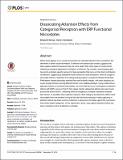Files in this item
Dissociating attention effects from categorical perception with ERP functional microstates
Item metadata
| dc.contributor.author | Dering, Benjamin | |
| dc.contributor.author | Donaldson, David I. | |
| dc.date.accessioned | 2020-01-30T17:30:02Z | |
| dc.date.available | 2020-01-30T17:30:02Z | |
| dc.date.issued | 2016-09-22 | |
| dc.identifier | 266042024 | |
| dc.identifier | 9791c676-f281-4490-8796-d4201e3db7cd | |
| dc.identifier | 84992186827 | |
| dc.identifier.citation | Dering , B & Donaldson , D I 2016 , ' Dissociating attention effects from categorical perception with ERP functional microstates ' , PLoS ONE , vol. 11 , no. 9 , e0163336 . https://doi.org/10.1371/journal.pone.0163336 | en |
| dc.identifier.issn | 1932-6203 | |
| dc.identifier.other | ORCID: /0000-0002-8036-3455/work/68281969 | |
| dc.identifier.uri | https://hdl.handle.net/10023/19389 | |
| dc.description | The research was supported by a University of Stirling Research Impact Fellowship awarded to B.D. | en |
| dc.description.abstract | When faces appear in our visual environment we naturally attend to them, possibly to the detriment of other visual information. Evidence from behavioural studies suggests that faces capture attention because they are more salient than other types of visual stimuli, reflecting a category-dependent modulation of attention. By contrast, neuroimaging data has led to a domain-specific account of face perception that rules out the direct contribution of attention, suggesting a dedicated neural network for face perception. Here we sought to dissociate effects of attention from categorical perception using Event Related Potentials. Participants viewed physically matched face and butterfly images, with each category acting as a target stimulus during different blocks in an oddball paradigm. Using a data-driven approach based on functional microstates, we show that the locus of endogenous attention effects with ERPs occurs in the N1 time range. Earlier categorical effects were also found around the level of the P1, reflecting either an exogenous increase in attention towards face stimuli, or a putative face-selective measure. Both category and attention effects were dissociable from one another hinting at the role that faces may play in early capturing of attention before top-down control of attention is observed. Our data support the conclusion that certain object categories, in this experiment, faces, may capture attention before top-down voluntary control of attention is initiated. | |
| dc.format.extent | 1352547 | |
| dc.language.iso | eng | |
| dc.relation.ispartof | PLoS ONE | en |
| dc.subject | QH301 Biology | en |
| dc.subject | Agricultural and Biological Sciences(all) | en |
| dc.subject | Biochemistry, Genetics and Molecular Biology(all) | en |
| dc.subject | DAS | en |
| dc.subject.lcc | QH301 | en |
| dc.title | Dissociating attention effects from categorical perception with ERP functional microstates | en |
| dc.type | Journal article | en |
| dc.contributor.institution | University of St Andrews. School of Psychology and Neuroscience | en |
| dc.identifier.doi | 10.1371/journal.pone.0163336 | |
| dc.description.status | Peer reviewed | en |
This item appears in the following Collection(s)
Items in the St Andrews Research Repository are protected by copyright, with all rights reserved, unless otherwise indicated.

